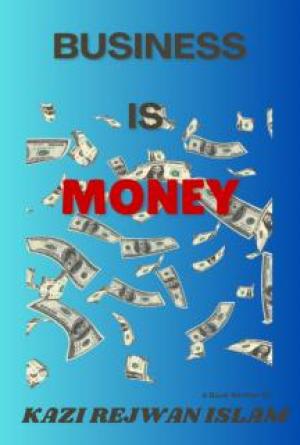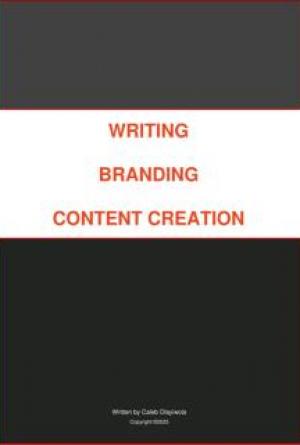The most valuable of business assets!
A complimentary e-book from Ace Business Promotions*
Presented By John Marchant
www.acebizpromo.co.uk
© Copyright Coker Trading Company Limited 2010
*Ace Business Promotions is a trading name of Coker Trading Company Limited Registration number: 4967108 Registered in England Registered office: Foxhole House, Yeovil Road, East Coker, Somerset, BA22 9HH, England
The most valuable of business assets!
This e-book is provided to help you understand what goodwill is, why it is such a valuable asset to you and the two most essential elements of your business that contribute to the value of its goodwill. We’ll then go on to discuss where marketing, and particularly online marketing, fits into the picture.
The e-book is structured as follows:
Part 1 What is goodwill?
Part 2 Why is goodwill a valuable asset? How is it measured?
Part 3 How can you create goodwill?
Part 4 How does the Internet fit in?
Part 5 Summary
Please note that our e-book is not a definitive work on the creation or valuation of goodwill. It is provided to you, without charge, simply to stimulate thought as to how you can get the absolute maximum out of your business in both the short and long term. We hope you find it useful.
The most valuable of business assets!
Part 1 – What is Goodwill?
Let’s start with: “Why is it the most valuable of business assets?” Because you, the small business owner or manager, can create it from nothing and for very little or no cost! By the application of sound principles and a degree of persistence you can create an asset of enormous value.
So, what is goodwill?
The simplest definition of goodwill is that it is the amount that a purchaser of a business is prepared to pay for it in excess of the value of its other assets less its liabilities.
Let’s take a restaurant as an example.
The business may operate from premises that have a value – a “bricks and mortar value” – of say $250,000. The equipment, fixtures and fittings of the business may be worth $40,000. It may carry stock of $10,000. That’s a total value of $300,000. But if the restaurateur, who has done very well out of his business and wishes to retire from it, puts it up for sale he may market it with an asking price of, say, $550,000 and after negotiating with various potential purchasers may eventually do a deal to sell it for $525,000.
Why is this, you may ask yourself? Why would anyone pay more for a business than the (apparent) value of its assets?
Well, there’s much more to the business than those tangible assets. There is the position of the premises, the customer base, the turnover and the profitability. There is also the influence of the present owner on the business and the ability of the business to continue producing profits without his hand on the helm. The potential purchaser will take into account all of these in considering how much he will pay for the business and pitch his offer accordingly.
You can see from the above that there can therefore be (at least) three different types of goodwill:
1. That attaching to the location of the business. Unless the business is mobile – e.g. an ice cream sales van – there may be
The most valuable of business assets!
an added value to the premises simply because they are occupied by that type of business in that location. The business may not have the same effect on the value of similar premises in a different location. Neither may the premises, as located, be as valuable if occupied by a different type of business. We therefore have “premises goodwill” – the added value because those particular premises are occupied by that type of business in that location.
2. Personal goodwill. Personal goodwill is the goodwill that attaches to the proprietor of the business. In some trades and professions the principal, or owner, develops such a high personal reputation that customers flock to the business only because of him. Take the example of the restaurateur. If the owner of the business is also the head chef who develops a huge reputation for his cooking, with customers flocking from near and far, a significant amount of the goodwill of the business is personal to him. If you were to buy the business how would you value that personal goodwill? Probably not very highly!
3. Last, but by no means least, there is the business goodwill. This is the goodwill that is attributed to the business’ ability to earn profits. It is that which you are left with after you strip away the other assets of the business, including the premises and personal goodwill. It is effectively the ability of the business to earn profits. It is the real, the genuine, goodwill of the business.
So there you have it.
Goodwill is the value of the business in excess of its other assets. The goodwill may attach to the business premises, it may be personal to the proprietor or a key member of staff or it may be the real goodwill of the business – its earning power. It is, of course, the latter in which we are interested. Throughout the remainder of this e-book when we refer to goodwill we will not be considering premises or personal goodwill but this genuine, business goodwill.
The most valuable of business assets!
Part 2 - Why is goodwill a valuable asset? How is it measured?
Yes, why is goodwill a valuable asset?
Basically because investors will pay a premium for a business or a share in a business that produces income at a level that will give them a return in excess of both the cost of the capital they have invested and the cost they attribute to the time they will have to devote to the business. The value of the goodwill of the business is, in essence, the amount that a purchaser or investor will pay or invest to obtain the right to receive that income.
We’ll stick with a restaurant and for ease of illustration we’ll assume that the premises are rented, all equipment is leased, the stock doesn’t have to be paid for until it has been sold so there is effectively nothing invested in it and there’s no personal goodwill. What’s left is the goodwill of the business.
So, how should a prospective purchaser or investor value this?
There are several criteria to take into account. The following list is not necessarily definitive but most of these considerations will apply to most business deals:
1. How much maintainable profit is the business generating? For the purpose of this illustration we’ll assume maintainable profits of $150,000.
2. What will be the cost of the capital invested in the business? This may be the amount of income forgone by moving capital out of another investment or it may be the interest and other charges if the capital invested is to be borrowed. We’ll assume a cost of capital of 5%.
3. What return on capital is required in excess of its cost. That is, what’s in it for me? Let’s say 15% is required.
4. How much time will the purchaser or investor have to devote to the business? We’ll say this is calculated to be worth $50,000.
The most valuable of business assets!
5. Finally, what degree of risk is attributed to the acquisition? This will determine the length of time over which recovery of the capital invested is spread. With a high risk business a return may be required over no more than a year. With a low risk business this may be much longer – 7 years, 10 years or even longer! We’ll assume that our investor has assessed a degree of risk such that he requires his capital to be returned in 3 years.
For the purpose of the illustration we’ll assume that interest is to be paid and the investment withdrawn from the business by 3 equal instalments at the end of each year 1, 2 and 3. The question is – how much can be invested?
First let’s have a look at the profits that will be available to finance the investment, produce the required return and provide a balance to repay the capital:
$ Profit 150,000
Attributable to investor's time 50,000
Available 100,000
So, there is $100,000 available to cover the cost of the capital, the required return on the amount invested and repayment of the amount invested over a three year period. The following table illustrates how this would be achieved:
Opening balance $
Year 1 210,648
Year 2 152,778
Year 3 83,333
Annual Interest repayment $ $
42,130 100,000 30,556 100,000 16,667 100,000 Closing balance $
152,778 83,333 0
The annual interest is charged at 20% - that’s the 5% cost of the capital invested plus the 15% required return.
You can see that for a “risk period” 3 years, with the whole of the investment to be recovered in that period, the investor could pay $210,648 for this business.
This is a very simplistic illustration of the way in which goodwill is valued but it does include the critical elements. We must, however,
The most valuable of business assets!
disclaim any financial responsibility for any decision you may take using our illustration as a basis for the valuation of the goodwill of any business you may sell or acquire. In particular calculation of maintainable profits requires an in depth examination of the financial results achieved by the business over an extended period of time upon which we strongly recommend you obtain independent professional advice. We also recommend that you obtain appropriate professional advice in establishing the rate of return you require and degree of risk attaching to any investment you may consider or make.
What we have shown you, however, is that a business with no other real assets can become worth a significant amount purely due to the value of its goodwill.
The most valuable of business assets!
Part 3 – How can you create goodwill?
There are two key objectives when you set about building goodwill in your business:
1. Establishing a flow of customers who buy from you and then return to buy again, and again, and again – you get the idea?
2. As far as possible, automation of your customer service.
Within this e-book we will deal with point one above, the marketing issue. Point 2, how to develop a business that allows automatic customer service, will be dealt with in a separate e-book to be published shortly. To reserve your free copy please click here.
Before we get down to business with the marketing considerations, we offer a free mini course highlighting and dealing with common marketing issues. If you wish you can register to receive the mini course on our website home page by clicking here.
Right, here we go.
We can’t do better than use the first instalment of our mini course as an example of how essential is effective marketing to the success of any business. That instalment, entitled “The Clock With No Hands”, compares, believe it or not, a clock with no hands to a business with no marketing. Although the movement in a clock with no hands may be operating absolutely perfectly, what is the point if there are no hands to tell the time? A business, however small, may produce a top quality product or service but what is the point if there are no customers? Without promotion, advertising or publicity who will know about it? Where will the customers come from? Think about marketing as of the business as the hands of the clock. It tells the world what it’s all about!
It’s the marketing, of the business and its products, that produces the customers that has a huge effect on the value of the goodwill of the business. If it didn’t cross your mind in Part 2 of this e-book, think about the critical criteria in the goodwill valuation. There were two highly sensitive constituent parts of the valuation:
1. The value of goodwill was effectively a multiple of profits.
The most valuable of business assets!
2. The multiple is determined by the degree of risk the purchaser attributes to the acquisition of the business.
Now, the essential point to grasp is that an effective marketing and promotional policy can both maximise profits and minimise risk!
An effective marketing policy will attract customers to your business but as important is that when they arrive they get what they expect. They will then become satisfied customers.
Your marketing must attract customers but you must only ever promise what you can deliver. You should not make claims that you cannot live up to on quality, quantity or any other criteria. In making the buying decision your customer will rely on the claims you make in your marketing. Exaggerations or false claims will not only result in high levels of returns, and the related cost, but also in dissatisfied customers who will not come back to you, certainly will not recommend you and in all probability will give your business the bad name that it deserves.
The key is to develop a quality product or service at an acceptable price. Then, yes, be different with your marketing, be eye catching and do all you can to attract customers but do it honestly without making claims or promises that you cannot keep. You will gradually build up a mass of satisfied, loyal customers that come back to you time after time!
This is not a lesson in marketing and we will not go there. It is the effect that the marketing has on the goodwill of your business that we are dealing with in this e-book – and particularly the effects on profits and risk.
Attracting a constant stream of new customers is essential to a profitable business. They spend with you and that generates profits for you. Keeping those customers satisfied also has a huge effect on profits. Once they become a customer if they return to buy from you time and time again there is very little cost to generating that business. They become “your” customer, not the customer of a competitor, who will have his work cut out to prise them away from you.
Can you see the effect this will also have on the risk attributed to your business when a potential purchaser is considering the value he is
The most valuable of business assets!
prepared to pay for the goodwill of the business? If he can see a customer base that is loyal to your business and where there are few returns how much more confidence would he have than if there are high levels of returns and customers don’t return to you.
What’s more, there is a twofold effect on the confidence of the prospective buyer – you could say it is doubled. He will be more confident in the level of maintainable profits and he will attribute less risk to acquiring your business.
You win and you win again!
The most valuable of business assets!
Part 4 – How Does the Internet Fit In?
However large or small your business – whether it’s a worldwide conglomerate or a local business serving customers within a radius of only a few miles – if you’re not marketing on the internet you’re missing a trick.
What’s more, it’s safe to say that your competitor that has appreciated the power of the internet and embraced it as a marketing tool will be stealing a march on you. He will be attracting customers that could be yours!
The internet search engines are used nowadays to find almost everything, however “local” the requirement or need may be – and there’s little doubt that if your business is not there, represented at the top of the first page on the search engines, that you are missing out on what could potentially be a life changing number of customers. Those customers are the ones that could become your loyal, repeat customers that could contribute so much to the value of the goodwill in your business. They are the ones that could enable your business to reach that next level, say so that you could appoint a manger to take away a load of the day to day chores and administration and free up your time. It could put you on a huge step towards “automation” of your business – that other essential factor in generating valuable goodwill.
Many proprietors or managers of small, local businesses are not aware that the internet could have such an impact on their business. They think it is too expensive or too difficult for them. Nothing could be farther from the truth!
There’s little doubt that in the past some so called internet marketing experts have enshrined online advertising in a mystery of technical jargon so that you or I could not hope to understand it. Then they’ve charged the earth to develop an internet marketing campaign for you, but with no guarantees! We’re not pointing the finger and there are undoubtedly many genuine service providers out there, but just as undoubtedly there are those who have taken the uninitiated for a ride.
What you, the small business owner or manager, need to understand is that there are strategies available that cost little or nothing that are so easy to implement (if you have succeeded in downloading and printing
The most valuable of business assets!
this e-book you have all the “technical ability” that you need) that you could see your business topping the search engines within a few days. You could also come to dominate the front page of the search engines for “local” searches.
The cost of this is, for many of the strategies available, nothing. For others there may be a small cost and if any of the strategies you feel you cannot deal with yourself they can be bought in for only a few $s or £s!
This e-book is not about marketing but about generating valuable goodwill in your business. You can see the value that could be added by a serious internet presence. If you click here you can view an introductory video (there’s no cost or obligation – not even an e-mail list opt in to complete unless you wish to) to the internet strategies available to you and to an example of the hugely valuable, low cost training that is available.
The most valuable of business assets!
Part 5 – Summary
So, what have we learned from this e-book?
It’s probably easiest to list the key points:
1. Goodwill is the amount a purchaser of a business is prepared to pay for that business in excess of the value of its other assets less liabilities.
2. Goodwill can be premises related, personal or genuine business goodwill. We have looked only at the business goodwill.
3. The value of goodwill is, in effect, a multiple of the maintainable profits of a business and the level of risk attributed to its acquisition.
4. The marketing policy of the business has a huge influence on both maintainable profits and risk by generating a base of satisfied customers upon which the business can rely.
5. “Automation” is also a significant factor in valuing goodwill but falls outside the scope of this e-book.
6. It is essential that the internet is in the marketing armoury of even the smallest, most local business if potential customers are not to be “stolen” by competitors.
7. Marketing on the internet is neither difficult nor expensive. Valuable training can be found
here.
Presented with the compliments of Ace Business Promotions. For more information click here.
To register to receive our next e-book,
"The Key to Building Business Goodwill - The Automatic Business", click here.
© Copyright Coker Trading Company Limited 2010
*Ace Business Promotions is a trading name of Coker Trading Company Limited Registration number: Registered in England
Registered office: Foxhole House, Yeovil Road, East Coker, Somerset, BA22 9HH, England







